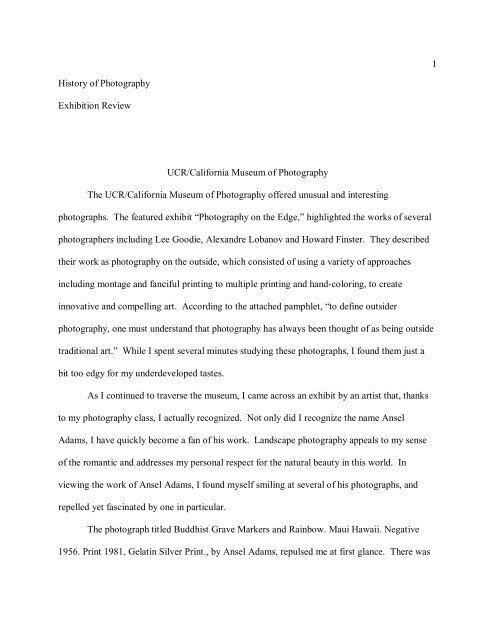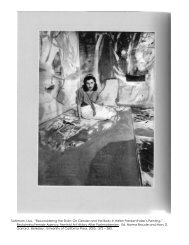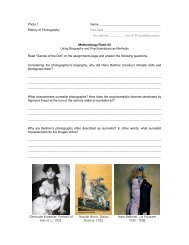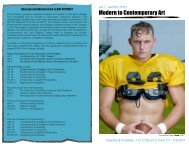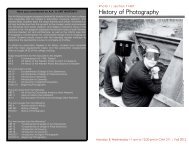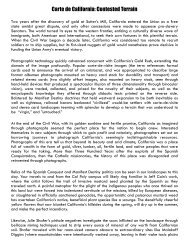example exhibition review - the Slide Projector!
example exhibition review - the Slide Projector!
example exhibition review - the Slide Projector!
You also want an ePaper? Increase the reach of your titles
YUMPU automatically turns print PDFs into web optimized ePapers that Google loves.
1<br />
History of Photography<br />
Exhibition Review<br />
UCR/California Museum of Photography<br />
The UCR/California Museum of Photography offered unusual and interesting<br />
photographs. The featured exhibit “Photography on <strong>the</strong> Edge,” highlighted <strong>the</strong> works of several<br />
photographers including Lee Goodie, Alexandre Lobanov and Howard Finster. They described<br />
<strong>the</strong>ir work as photography on <strong>the</strong> outside, which consisted of using a variety of approaches<br />
including montage and fanciful printing to multiple printing and hand-coloring, to create<br />
innovative and compelling art. According to <strong>the</strong> attached pamphlet, “to define outsider<br />
photography, one must understand that photography has always been thought of as being outside<br />
traditional art.” While I spent several minutes studying <strong>the</strong>se photographs, I found <strong>the</strong>m just a<br />
bit too edgy for my underdeveloped tastes.<br />
As I continued to traverse <strong>the</strong> museum, I came across an exhibit by an artist that, thanks<br />
to my photography class, I actually recognized. Not only did I recognize <strong>the</strong> name Ansel<br />
Adams, I have quickly become a fan of his work. Landscape photography appeals to my sense<br />
of <strong>the</strong> romantic and addresses my personal respect for <strong>the</strong> natural beauty in this world. In<br />
viewing <strong>the</strong> work of Ansel Adams, I found myself smiling at several of his photographs, and<br />
repelled yet fascinated by one in particular.<br />
The photograph titled Buddhist Grave Markers and Rainbow. Maui Hawaii. Negative<br />
1956. Print 1981. Gelatin Silver Print., by Ansel Adams, repulsed me at first glance. There was
2<br />
something morbid and very unsettling about <strong>the</strong> stacking of grave monuments depicted in this<br />
photograph. This unexpected and strangely disturbing photograph by Ansel Adams, led me to<br />
imagine that <strong>the</strong>y buried more than one individual beneath this collage of grave markers. It gave<br />
me chills and yet, I could not ignore it.<br />
The center of focus for this photograph is <strong>the</strong> entire grave marker, a continuous balance<br />
of light and dark which gave me <strong>the</strong> impression that <strong>the</strong> effect was completely natural and<br />
untouched by <strong>the</strong> photographer. I do not know if <strong>the</strong> artist manipulated this print (I remember<br />
reading that Adams was a pictoralist at one time), but <strong>the</strong> contrast made me believe that o<strong>the</strong>r<br />
things had taken place just outside my own comprehension. A battle may have been going on<br />
between good and evil. The sizes of <strong>the</strong> markers, <strong>the</strong> similar shapes with smooth rounded tops or<br />
sharp square edges, and <strong>the</strong> surrounding landscape hinted at this being a graveyard of unusual<br />
proportions. This feeling prevailed even into <strong>the</strong> rocks lining one side of <strong>the</strong> photo. Every<br />
where in <strong>the</strong> photograph <strong>the</strong>re is light playing off dark, black versus white, encompassed in<br />
shades of gray.<br />
I believe that Adams intentionally chose a time of day when <strong>the</strong>re would be little natural<br />
or day light, in order to direct your eye to <strong>the</strong> center of <strong>the</strong> photograph. It may also be <strong>the</strong> reason<br />
why <strong>the</strong>re are very few shadows, that and <strong>the</strong> angle <strong>the</strong> Adams choose to shoot from. This<br />
choice greatly emphasizes <strong>the</strong> differences in each marker, <strong>the</strong>ir markings and discolorations, and<br />
gives <strong>the</strong> light that shines on <strong>the</strong> very top marker greater significance. The lighted top marker,<br />
which has dark engravings down <strong>the</strong> front and a dark round ball with what appear to be grooved<br />
plates attached to <strong>the</strong> sides, looks as though it has fought its way up through <strong>the</strong> markers and<br />
now triumphantly stands atop <strong>the</strong> pile, victorious and wearing a crown.
3<br />
Then <strong>the</strong>re is <strong>the</strong> rainbow, natural or unnatural, it symbolized for me a sense that after all<br />
conflict has ceased, <strong>the</strong>re is hope. The rainbow racing across <strong>the</strong> gray sky gives one <strong>the</strong><br />
impression that it was time to rest. The fact that <strong>the</strong>re is a rainbow in <strong>the</strong> midst of this black and<br />
white world seems very pictoralist in style and romantic in nature. Where exactly did it stem<br />
from? Although <strong>the</strong>re is an ocean just past <strong>the</strong> edge of <strong>the</strong> rocks which line <strong>the</strong> right side of <strong>the</strong><br />
photograph, <strong>the</strong> time of day does not seem conducive to rainbows. Yet it could have been <strong>the</strong><br />
photographer’s intention to leave you questioning this particular phenomenon. Does this rainbow<br />
originate here or is it even an original part of <strong>the</strong> photograph? The fact that I was unable to<br />
answer <strong>the</strong>se questions during my research only made this photograph that much more engaging<br />
and intriguing. I cannot say if I liked or disliked this photograph. What I can honestly say is that<br />
I was fascinated by and curiously drawn to this photograph, in spite of my initial feelings of<br />
revulsion.<br />
There were o<strong>the</strong>r Ansel Adams photographs on display. Among <strong>the</strong>m were Trailside<br />
near Juneau, Alaska.c.1944.; Clearing Winter Storm, Yosemite National Park, California.c.1944.<br />
Gelatin Silver Print; Monument Valley, Arizona.c.1985; and, Mission San Xavier del Bac.<br />
Tucson, Arizona. I can say without qualification that I found <strong>the</strong>se and o<strong>the</strong>r <strong>example</strong>s of his<br />
work, viewed online, quite appealing. The fact that Ansel Adams was a great nature lover<br />
explains why I am thoroughly drawn to his photographs. For me, nature is <strong>the</strong> greatest artist of<br />
all time. Overall, I thoroughly enjoyed my visit to <strong>the</strong> UCR/California Museum of Photography.<br />
It is an experience that I look forward to repeating.


